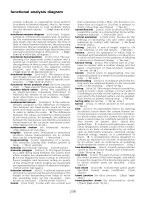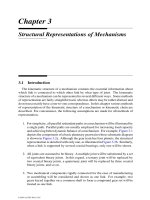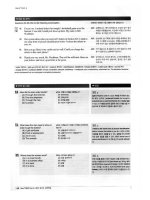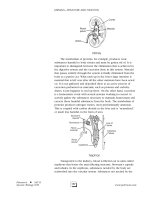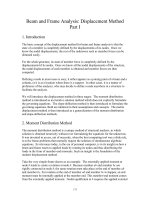Handbook of Lubrication Episode 2 Part 1 pdf
Bạn đang xem bản rút gọn của tài liệu. Xem và tải ngay bản đầy đủ của tài liệu tại đây (1.73 MB, 20 trang )
calcium and ferrosilicon as deoxidizing materials. Aresulting low-melting ternary inclusion
then spreads over the tool face in high-speed machining and acts as a diffusion barrier.
Coated Tools
In the late 1960s crater formation was found to be retarded by the vapor phase deposition
of a very thin (0.0002 in., 5 µm) coating of TiC on a steel cutting grade carbide tool. It
was later found that such coatings also tended to reduce the wear-land wear. The TiC coating
provides a material in contact with the iron surface of the chip that is less likely to give up
its carbon than WC. Use of such a coating avoids the tool-weakening effect associated with
relatively large additions of TiC or TaC to the tool in bulk.
Tools have also been coated with A1
2
O
3
and this material is thought to function as a
diffusion barrier which is one of the mechanisms believed responsible for the success of the
specially deoxidized steels.
In addition to TiC, other coating materials is use include TiN, HfC and HfN. All of these
appear to provide a more stable material relative to decomposition in the presence of hot
iron and at the same time act as diffusion barriers. ATiN coating gives lower tool-face
friction than TiC when cutting a low-alloy steel. Although TiC is more stable than WC there
will be some decomposition of TiC. The carbon that is released will be absorbed by the
low-carbon steel, thus strengthening it and causing an increase in tool-face friction. TiN
does not appear to be as good a diffusion barrier as TiC, but when it decomposes the nitrogen
released does not have as great a strengthening action on the steel as does carbon. This
results in lower tool-face friction for a TiN coating than for a TiC coating.
13
Tools have also been coated with A1
2
O
3
which also acts as a diffusion barrier. The subject
of tool coating is a rapidly developing and further important developments are expected.
Cutting Fluids
Cutting fluids have a dual role — cooling and lubrication. In high-speed cutting operations
where the tool remains buried in the cut most of the time, such as in turning, the function
of the fluid is primarily one of cooling. In low-speed operations involving intermittent cutting,
such as in broaching or tapping, lubrication is important. Both water-base and oil base
lubricants are used, the former are generally better coolants while the latter are better
lubricants. There are many secondary considerations associated with cutting fluids such as
chip disposal, corrosion prevention, health and safety considerations, etc. Adiscussion of
these aspects of cutting fluid technology is to be found in Reference 14 and in the next
chapter of this handbook.
It is unlikely that anything but a vapor can penetrate the interface between chip and tool
during a continuous cutting operation. This is due to the near perfect contact between chip
and tool and the normally high-speed motion of the chip counter to fluid penetration. From
the latter point of view it is unlikely that any penetration will be from the side of the tool
(i.e., parallel to the cutting edge).
CHIPFORMATION AND CHIPCONTROL
Figure 15 shows several types of chips formed under different operating conditions.
Discontinuous chip formation is shown at (a) and cutting with a large BUE is shown at (b).
Cutting with the continuous ribbon-like chip previously discussed is illustrated at (c). When
the work material is very soft and extensive, strain-hardening occurs during cutting or when
the friction between chip and tool is high, the narrow shear zone shown in (c) assumes a
fan shape as shown at (d).
Cooling the back of the chip will frequently cause the chip to curl away from the tool (e)
resulting in a decrease in the contact length between chip and tool. There is an optimum
Volume II 349
335-356 4/11/06 12:34 PM Page 349
Copyright © 1983 CRC Press LLC
MACHINING ECONOMICS
In a single-tool turning operation, the machining cost per part will depend upon the rate
of metal removal (Z
·
, in.
3
/min) or (mm
3
/min).
(24)
where V = cutting speed, fpm (m/mm); b = depth of cut, in. (m); t = feed rate, in./r
(mm/v) = undeformed chip thickness. The depth of cut will normally be fixed by the amount
of material to be removed, but the operator may select the values of speed (V) and feed (t).
The cost to make a cut of ᐉin.(m) axial length on a bar of D in.(mm) diameter will be
(25)
where x = value of machine, operator and overhead (¢/min), T
c
= cutting time (min), T
d
= down time to change the tool (min), y = mean value of cutting edge (¢), T = tool life
(min), and T
w
= work changing time (min). Item I = machine and labor cost per part,
item II = tool and tool changing cost per part, and item III = work changing cost per part.
Certain values of V and t will give a minimum cost per part and since an increase in t
will cause a smaller decrease in tool life (T) than will an increase in V, it is advantageous
to adjust t relative to machining cost before adjusting V. However, the cost optimum value
of t usually lies beyond the practical range in turning. That is, the cost per part will decrease
with increase in t, but before the cost optimum value can be reached, (t*), a constraint will
be encountered such as finish, power, force on tool (breakage), chatter, surface integrity,
etc. On the other hand, the cost optimum value of V (V*) usually lies within the practical
range.
For a constant value of t, the Taylor Equation 21 relates tool life (T) in min and the
cutting speed (V) in fpm VT
n
= C, where n and C are constants. The value of cutting time
(T
c
) will be
(26)
where ᐉ,
=
axial length of cut, in. (m), D = diameter of work, in. (mm), and C
1
= a
constant for a constant value of t.
Volume II 351
FIGURE 16. Carbide chip curler used to pe-
riodically break chips to simplify chip disposal.
I = tungsten carbide insert.
335-356 4/11/06 12:34 PM Page 351
Copyright © 1983 CRC Press LLC
Substituting Equations 21 and 26 into Equation 25:
(27)
The quantity (xT
w
) may be considered independent of V. The cost per part (¢) will be a
minimum when ∂¢/∂V = 0. This occurs when the cost optimum value of tool life is
(28)
For a carbide tool n ~
_
0.2 and, therefore, T* = 4R if x = 10 ¢/min, T
d
= 10 min, and
y = 100¢. Then, R = 20 min
–1
and T* = 80 min. For a HSS tool, n ~
_
0.1 while for a
ceramic tool n ~
_
0.4 and the corresponding values of T* in the above example would be
180 min (HSS) and 30 min (ceramic).
When more than one tool is used, the value of R to be used is approximately the sum of
the values of R for the individual tools. This results in the cost optimum tool life (T*) being
greater the greater the number of tools used at one time.
Manual Adaptive Control
18
is a technique for adaptiveiy controlling a machine tool with
practically no investment in capital equipment beyond that required for ordinary machining.
In this case, the operator acts as the group of sensors required in adaptive control and also
serves as the interface between the machine tool and the low cost (~ $250) computer. After
each tool change, he enters the time elapsed from the last tool change and the number of
parts produced. The programed computer then tells the operator to increase or decrease the
production rate in order to approach minimum cost per part.
GRINDING
Grinding is one of the most versatile methods of removing material from machine parts
to provide precise geometry. However, the process is very complex and difficult to study
because of the small size of the individual chips produced by hard abrasive particles having
a wide range of shape, spacing, and relative elevation.
Grinding operations may conveniently be classified in terms of whether the wheel is
dressed or whether the wear of the wheel is sufficiently high that it is self-dressing. In form-
and-finishing grinding (FFG), individual chips are relatively small and wear flats develop
on the active grains in the surface. Periodically the dull grains are removed or “sharpened”
by dressing the wheel with a diamond tool. Typical FFG operations are horizontal spindle
surface grinding, internal grinding, cylindrical grinding, and centerless grinding. In stock
removal grinding (SRG) wheel wear is relatively high and the wheel is self-dressing. Ex-
amples of SRG are abrasive cut off processes, conditioning of slabs and billets in a steel
mill and vertical spindle surface grinding.
The rate of wear of a grinding wheel is usually important to the economics and performance
of the process. In the case of SRG wear is usually expressed in terms of a grinding ratio
(G).
In such cases, the rate of change of wheel diameter is relatively large and G may easily be
measured.
In the case of FFG there is usually a negligible change in wheel volume during grinding
and essentially all of the wheel consumption is associated with dressing. In such cases, the
G =
volume of work removed
volume of work consumed
352 CRC Handbook of Lubrication
335-356 4/11/06 12:34 PM Page 352
Copyright © 1983 CRC Press LLC
grinding ralio is not a convenient way of measuring wheel life. Instead, some means of
accurately measuring the change in wheel radius, or alternatively some means of measuring
the development of wear flats on the active abrasive grains must be devised. Such meas-
urements are very difficult to make on a complete grinding wheel.
Grinding Mechanics
The mechanics of grinding is discussed in detail in Reference 19 and, therefore, only a
few essentials will be reviewed here. Figure 17a shows a plunge surface grinding operation.
The term plunge infers that there is no cross feed in the direction of the wheel axis. The
wheel width is greater than the work width (b) and the wheel and work speeds are V and
v, respectively. The wheel depth of cut is d. The mean undeformed shape of the chip is
shown in Figure 17b, while Figure 17c shows the cross section of an undeformed chip at
its midpoint. The maximum undeformed chip thickness (t) may be found as follows:
(29)
where C is the effective number of cutting points per square inch. The volume of a single
chip can also be found by assuming the shape of the chip to be a long slender triangle, in
which case
Volume of single chip =
1
/
2
A
_
ᐉ (30)
where A
_
is the mean cross-section of the chip (= b′t/2) and b′ is the effective chip width.
It is convenient to define b′ in terms of the ratio (r) of chip width (b′) to chip thickness (t),
thus
(31)
Substituting Equations 31 into 30 and equating the chip volumes from Equations 29 and 30:
(32)
Volume II 353
FIGURE 17. Undeformed chip shape in grinding.
abc
335-356 4/11/06 12:34 PM Page 353
Copyright © 1983 CRC Press LLC
The quantity t has been shown to be the most important quantity relative to grinding
performance
20
and can be readily estimated if C, r′and ᐉare known. The difficulty in
estimating C and some of the techniques used can be found in References 21 to 23. The
length of scratch (ᐉ, Figure 17a) may be estimated as follows, if local wheel and work
deflection are negligible
(33)
The value of t in FFG is generally about 100 µin. For such small cuts a very small part
of the abrasive grain is active and the removal mechanism differs substantially from that of
the concentrated shear mechanism that pertains in cutting (as shown in Figure 2).
In fine grinding, the removal mechanism is more akin to that of an indentation hardness
test.
24
Figure 18a shows the plastic zone that develops beneath a spherical indenter.
25
Figure
18b shows a typical blocky abrasive grain. Only a small percentage of such a grain produces
a chip in fine grinding and the effective rake angle will be even more negative than that
corresponding to the inclined faces at the lowest point on the grain of Figure 18b. Actually,
the very small radius at the active point on the grain will be responsible for the effective
rake angle as shown in Figure 18c. Here the action is likened to that of a spherical indenter
subjected to an inclined load. The effective radius of this indenter will of course be much
smaller than that of the dotted circle shown in Figure 18b. Material to the front of the
indenter of Figure 18c will be plastic but unsupported and will flow upward to generate the
chip.
The consequences of the chip-forming mechanism shown in Figure 18c are the following:
1.Deformation of a much larger volume of material than escapes as a chip.
2.Considerably greater subsurface flow than with the cutting mechanism shown in Figure
2, leading to a greater tendency for subsurface cracking and for residual stresses in
grinding than in cutting.
3.Agreater proportion of the total energy in fine grinding will end up in the workpiece
surface than in metal cutting. In high speed cutting, 90% or more of the energy consumed
ends up in the chip, while in fine grinding most of the energy ends up in
the work (~80%).
The fact that the specific energy in fine grinding is 50 times or more greater than that for
cutting the same material is in agreement with the extrusion-like mechanism shown in Figure
354CRC Handbook of Lubrication
abc
FIGURE 18. Chip-forming mechanism in fine grinding and its relation to hardness indentation.
335-356 4/11/06 12:34 PM Page 354
Copyright © 1983 CRC Press LLC
18 as are other experimental observations. Also adding to the specific grinding energy is
the fact that metal is pushed from side to side several times before leaving as achip.
As the undeformed chip thickness (t) increases, a greater percentage of the abrasive particle
is active and the effective rake angle increases. For SRG where chips are quite large, the
removal mechanism approaches that of Figure 2 and there is much less danger of overheating
the work since more energy consumed ends up in the chip rather than in the workpiece. In
the abrasive cut-off operation, chips are relatively large and the specific grinding energy
will be only about 1 × 10
6
in.lb/in.
3
(6.9 × 10
6
kPa) instead of about 30 × 10
6
in.lb/ in.
3
(207 × 10
6
kPa) for horizontal surface grinding and as much as 100 x 10
6
in.lb/in.
3
(690
× 10
6
kPa) for internal grinding.
SURFACE INTEGRITY
In many cases the quality of the finished surface is an item of major concern. This involves
items such as
1. Surface finish
2. Residual surface stresses
3. Thermally induced damaged: oxidation and burning, overtempering, surface cracks
4. Mechanically induced surface cracks and highly strained areas (BUE)
From the standpoint of brittle fracture and fatigue, any residual surface stresses should
be compressive. When surface integrity is a problem, the use of sharp tools and cutting
conditions to avoid BUE formation or overheating the surface are principal items for con-
sideration. Since the cutting temperature varies as (V)
1/2
, high temperature problems are
more apt to occur in grinding since V will normally be 6000 fpm (30 m/sec) or greater.
When excess grinding temperatures are a problem, a shift to a lower wheel speed (~ 2000
fpm or 10 m/sec), use of a sharp wheel (frequent dressing), lower removal rates and an
active oil-base lubricant will usually be helpful.
In addition to the references cited above, References 26 to 35 provide further background
concerning material removal operations.
REFERENCES
1. Shaw, M. C., Metal Cutting Principles, MIT Press, Cambridge, 1954.
2. Merchant, M. E., Mechanics of the cutting process, J. Appl. Phys., 16, 267, 1945.
3. Piispanen, V., Lastumuodosiumisen teoriaa, Tek. Aikak., 27, 315, 1937.
4. Trent, E. M., Advances in machine tool design and research, Proc. 8th Machine Tool Design Res. Conf.,
Tobias S. A. and Koenigsberger, F. M., Eds., Pergamon Press, Oxford, 1967, 629.
5. Opitz, H., DerHeutige Stand der Zerspannungsforschung, WerkstatistechnikMaschinenbau, 46, 210, 1956.
6. Shaw, M, C., Wear mechanisms in metal processing, Proc. Int. Tribology Conf., MIT Press, Cambridge,
1979.
7. Taylor, F. W., On the art of metal cutting, Trans. ASME, 28, 31, 1907.
8. Vilenski, D. and Shaw, M. C., The importance of workpiece softening on machinability, Ann. CIRP, 18,
623, 1969.
9. McKenna, P. W., U.S. Patent 2,113,353, 1938.
10. Opitz, H. and Koenig, W., Ind. Anzieger, 87, 46 (Part I), 26, 1965; Ind. Anzeiger. 87, 845 (Part II); 43,
1965; Ind. Anmger, 87, 1033 (Part III), 51, 1965.
11. Sata, T., Chairman, Working Group on Machinability in Japan, Bull. 3(1), Japan Society of Precision
Engineers, Tokyo, 1969.
Volume II 355
335-356 4/11/06 12:34 PM Page 355
Copyright © 1983 CRC Press LLC
12. Tipnb, V. A. and Joseph, R. A., J. Eng. Ind., Trans. ASME, 93, 571, 1971.
13. Rao, S. B., Kumar, K. V., and Shaw, M. C., Friction characteristics of coated tungsten carbide cutting
tools, Wear, 49, 353, 1978.
14. Shaw, M. C., Grinding fluids, Manuf. Eng. Trans., 1, 1972.
15. Henriksen, E. K., Balanced design will fit the chip breaker to the job, Am. Machinist, April 26, 1954.
16. Nakayama, K., A study on chip breaker, Bull, Jpn. Soc. Mech. Eng., 5(17), 142, 1962.
17. Subramanian, K. L. and Bhattacharya, A., Mechanics of chip breakers. Int. J. Prod. Res., 4(1), 37,
1965.
I8. Shaw, M. C. and Komanduri, R., Manual adaptive control, Am. Much., 121, 205, 1977.
19. Shaw, M. C., Fundamentals of grinding, keynote paper, 1st Int. Grinding Conf., Carnegie Mellon Univ.,
April 1972, in New Developments in Grinding, Carnegie Press, Pittsburgh, 1972.
20. Snoeys, R., The significance of chip thickness in grinding, Ann. CIRP. 23(2), 227, 1974.
21. Brecker, J. N. and Shaw, M. C., Measurement of the effective number of cutting points in the surface
of a grinding wheel, Proc. Int. Conf. Prod. Eng. Tokyo, 1974, 740.
22. Peklenik, J., Ermittlung von geometrischen und physikalischen Kenngrossen fur die Grundlagen des
Schleifens, Dissertation T.H. Aachen, 1957.
23. Nakaysmua, K. and Shaw, M. C., Study of the finish produced in surface grinding. II. Analytical, Proc,
Inst. Mech. Eng. (London), 182(3K), 182, 1967-1968.
24. Shaw, M. C., A New Theory of Grinding, Institution of Engineers, Australia, 1972, 73.
25. Shaw, M. C. and DeSalvo, G. J., The role of elasticity in hardness testing, Metals Eng. Quart., 12, 1,
1972.
26. Amarego, E. J. A., and Brown, R. H., The Machining of Metals, Prentice-Hall, Englewood Cliffs, N.
J., 1966.
27. Boothroyd, G., Fundamentals of Metal Machining, McGraw-Hill, New York, 1975.
28. Ernst, H. et al., Machine Theory and Practice, American Society of Metals, Metals Park. Ohio, 1950.
29. Kronenberg, M., Machining Science and Applications, Pergamon Press, Oxford, 1966.
30. Trent, E. M., Metal Cutting, Butterworths, London. 1977.
31. Shaw, M. C., Ed., International Research in Production Engineering, American Society of Mechanical
Engineers, New York, 1963.
32. Zorev, N. N., Metal Cutting Mechanics, Pergamon Press, Oxford, 1966.
33. CIRP, Yearly Proc. Int. Inst., Prod, Eng, Res., Paris, Ann. CIRP, 1952 to Present.
34. Machine Tool Design and Research - Yearly Proceedings of Conference held in Great Britain UMIST,
Manchester, 1962 to Present.
35. Proceedings of Yearly North American Metal Working Research Conferences (NAMRC) Society of Man-
ufacturing Engineers, Dearborn, Mich., 1972 to Present.
356 CRC Handbook of Lubrication
335-356 4/11/06 12:34 PM Page 356
Copyright © 1983 CRC Press LLC
CUTTING FLUIDS
Ralph Kelly and Gregory Foltz
INTRODUCTION
The primary function of any cutting fluid is to control heat.
1
A cutting tool generates
temperatures of 375 to 750°C and the resulting chip as it slides up the tool face creates
tremendous pressures (up to 1,379,000 kPa). About 75% of the heat is generated by de-
formation of the metal, the other 25% by friction between the chip and the tool. By controlling
the temperature generated in the cut zone, tool wear can be controlled and tool life increased.
2
As the cutting tool cuts (or the grinding wheel grinds), metal deforms by shear or plastic
flow along a shear plane extending from the top of the tool to the surface of the metal
(Figure 1). Below the shear plane is undisturbed metal; above it, the deformed metal forms
a chip. Reduced friction at the chip-tool interface increases the shear angle, produces a thin
chip, and deforms less metal.
Where a tool face is examined under a microscope, rough peaks and valleys can be seen
(Figure 2). These tiny projections collide with the chip as it slides up the tool face and weld
to the chip under the conditions of very high heat and pressure. Continuous shearing of
these welds results in tool wear, the tip of the tool becomes cratered, and heat concentrates
at this point. Small pieces of sheared-off metal form a built-up edge on the face of the tool,
a major cause of poor surface finish.
When a cutting fluid is introduced between the tool and chip, friction is reduced, the
shear angle increases, the chip becomes thinner, the power requirement is reduced, and less
heat is generated. Also, the built-up edge disappears, the finish smooths out, and size control
improves. The nascent metal exposed under the high temperature and pressure conditions
reacts with chemicals in the cutting fluid to form a low shear strength solid between the
chip and the tool. The chip slides freely up the tool face, tools last much longer, speeds
and feeds can be stepped up, and more work can be done with each tool. The cooling and
lubricating mechanisms are dependent on the job: slow-speed, slow-feed operations need
more lubrication while high-speed, high-feed operations need more cooling.
TYPES OF CUTTING FLUIDS
3
Cutting Oils
A cutting oil contains mineral oil, fatty oil, or a combination of these. Mineral oils are
petroleum derivatives; fatty oils are derived from animal or vegetable sources.
Extreme pressure (EP) sulfur, chlorine, or phosphorus additives are employed to improve
antiweld properties for heavy-duty applications. Sulfur forms a better lubricant, but chlorine
is more reactive than sulfur and breaks down to form the EP lubricant at lower temperatures.
Phosphorus is not as effective as either sulfur or chlorine and its use is less common. Cutting
oils are often classified as active or inactive; an inactive oil will not darken a copper strip
immersed in it for 3 hr at 100°C while an active oil will. Inactive oils are straight mineral
oils, containing sulfurized fatty oils. Active oils are sulfurized or sulfochlorinated mineral
or fatty oils.
Straight mineral oil — Used for light-duty machining of ferrous or nonferrous metals,
its major function is as the base fluid for the blends and additive oils listed below.
Straight fatty oils — Very limited use because of their expense and frequent odor
problems. They find their greatest application in blends with mineral oils. Palm oil, lard
oil, and coconut oil are the most popular.
Volume II 357
357-369 4/10/06 2:13 PM Page 357
Copyright © 1983 CRC Press LLC
film in the machining process. This reduces friction and built-up edge, and provides antiweld
properties. These oils are useful for machining tough, ductile metals. Reactivity of the sulfur
makes them unsuitable for copper or copper alloys.
Sulfo-chlorinated mineral oil — Combination of sulfur and chlorine additives produces
products with exceptional antiweld properties over a wide temperature range. They are used
for machining (especially threading) tough, low-carbon steels. Fatty oils added to this type
of product produce a cutting oil for a wide range of heavy-duty and slow-speed operations.
Cutting oils generally provide the excellent lubrication needed in low-clearance, low-
speed operations; especially where a high quality surface finish is required. They have good
rust control. Sump life is long since rancidity-causing bacteria do not grow in pure oil unless
it is contaminated with water. The straight-oil cutting fluids do allow buildup of excessive
heat, since oil dissipates heat only half as fast as water and because it is much more viscous
than water-based fluids. These oils are also somewhat of a safety hazard in that they smoke
and burn. In addition, their high misting properties cause the parts and surrounding area to
become slippery and dirty.
Emulsified Oils (Soluble Oils)
These mixtures of mineral oil and emulsifiers (Figure 3) are supplied as concentrates
which are added to water at the ratio of 1 part concentrate to 5 to 20 parts water. The oil
is made soluble by emulsifying agents, primarily sulfonates. The emulsified particles range
in size from 200 to 80 μm, large enough to reflect light and create a milky, opaque appearance
when mixed with water. Premium grades may contain bactericides and corrosion inhibitors.
Addition of fatty oils, fatty acids, or esters produces a superfatted emulsion for heavy-duty
use on both ferrous and nonferrous metals. Sulfur, chlorine, or phosphorous, in addition to
the fat, form an extreme pressure emulsion for very heavy-duty operations, including re-
placement of straight cutting oil in some applications.
Used as general-purpose products, soluble or emulsified oils offer lubrication because
they contain oil, and the water aids in dissipating heat. Speeds and feeds can be stepped up
and better size control obtained.
Soluble oils have several disadvantages. When mixed with hard water, some soluble oils
form a precipitate which is deposited on parts and machines, and which can interfere with
filtration. In extreme cases, the emulsion may be broken. At strong concentrations, mist
from a soluble oil can leave machines and work areas in a messy, slippery condition.
Depending on the amount of rust preventives added, rust can be a problem. The water can
support bacterial growth, leading to rancid odors and short sump life if proper bactericides
are not present.
Volume II 359
FIGURE 3. Emulsified oils (soluble oils).
357-369 4/10/06 2:13 PM Page 359
Copyright © 1983 CRC Press LLC
Chemical Emulsions (Semisynthetics)
These (Figure 4) have a much lower mineral oil content than soluble oils (anywhere from
5 to 30% in the concentrate). They have a high emulsifier content and smaller oil globule
formation, which results in a mix that is translucent or transparent. Chemical emulsions
provide wetting and lubrication properties, corrosion control, and microbial control. These
fluids may also contain fatty acids, sulfur, chlorine, and phosphorous to enhance EP lubrication.
They generally have enough lubricity for moderate- to heavy-duty applications. With
better wetting properties than soluble oils, chemical emulsions make possible higher speeds
and feeds. Chemical emulsions usually have better settling and cleaning properties than
soluble oils, which contribute to a long and trouble-free sump life. Many chemical emulsions
contain wetting and cleaning agents to keep the machines clean. Because they contain very
little oil, chemical emulsions do not smoke. This reduction in oil also contributes to less
mist.
If hard water is used to make the mixture, these products, like soluble oils, may form a
hard-water scum. The cleaning action may cause some chemical emulsions to foam. While
their initial purchase price is generally higher, these products are usually less costly to use
than soluble oils.
Chemical Solutions (Synthetic Fluids)
These products (Figure 5) are true solutions and are completely clear. The simple type
consists of organic and inorganic salts dissolved in water. The more complex moderate- or
heavy-duty synthetics contain wetting agents which allow the fluid to spread more completely
over the metal surface, increasing the lubrication properties of the fluid. These products
usually have excellent microbial control.
The simple types are mainly used as grinding fluids since they offer rust protection and
good heat removal. The more complex types are good general-purpose products, offering
both good lubrication and fast heat removal. Use dilutions range from 5 to 0.5%, depending
on the type of solution and the operation. They keep the wheels open and free grinding,
they enable operators to see the work, and they produce considerably less mist than the
other types of cutting fluids. Of water-based fluids, solutions are the least troubled by
rancidity and their superior settling and cleaning properties help extend the fluid life. Their
excellent cooling capability makes possible high speeds and feeds, high production rates,
and good size control. Chemical solutions are stable, even in hard water. Although they
contain no oil, the chemical lubrication afforded through wetting agents does supply sufficient
360 CRC Handbook of Lubrication
FIGURE 4. Chemical emulsions (semisynthetics).
357-369 4/10/06 2:13 PM Page 360
Copyright © 1983 CRC Press LLC
with products having low to moderate friction -reducing properties. Some grinding can be
performed with cutting fluids that provide little friction reduction. Others, such as form
grinding, require a heavy-duty fluid. If performed regularly, the most critical operation in
a shop may dictate the cutting fluid selection.
Severity of the Operation
3,5
Although stock removal rates, feeds, speeds, and finish requirements must be considered,
operations can be divided into four general categories: (1) metal removal in which adhesion
between the chip and tool interface is minimal is considered light duty. Examples would be
turning 1112 steel or surface grinding cast iron; (2) moderate-duty operations are those in
which adhesion between the chip and tool is noticeable and contributes to poor finishes and
poor size control. Examples would be key seat milling and internal race grinding; (3) a
heavy-duty operation involves severe adhesion between the chip and tool. Examples would
be sawing of large parts, deep slotting, or centerless grinding heavy parts; and (4) extremely
heavy-duty operations involve extremely severe adhesion between the chip and tool and
small tool clearances, thus creating severe rubbing conditions between the tool and work-
piece. Examples are thread chasing and tapping 4140 steel, deep hole drilling, or form and
thread grinding. As severity increases, it may also be necessary to increase the lubricity of
the fluid.
Materials
5
Aproduct providing excellent ferrous corrosion protection may stain aluminum alloys.
Glass, molybdenum, and nodular iron require a fluid with excellent grit-settling character-
istics. Magnesium alloys are generally machined or ground with straight oil products because
of the danger of hydrogen gas evolution in water-based products. Good control of chip
removal has allowed some use of soluble oils for magnesium machining.
Machinability is one means of differentiating between metals. Amachinable metal allows
tooling to last longer, can be machined easily at high speeds, or exhibits in some other terms
its ability to be machined. Variations in microstructure, amounts of alloy material, heat
treatment, and many other factors can affect machinability. Taking SAE 1112 steel as 100%
machinable, other metals are divided in Table 1 into six machinability classes.
3
These
machinability classes have been used in the fluid selection chart of Table 2. Because various
components or additives in a cutting fluid may stain some alloys of a given metal, corrosion
tests should be run to insure compatibility.
Type of System
6
Premix tanks, proportioners, periodic machine cleaning, and frequent concentration checks
are very helpful in maintaining the fluid in a good working condition. Care is especially
important in machines with no filtration other than simple settling.
In nonrecirculating systems, the fluid is applied and then discharged in a one-time use.
This is practical with many portable tools and in mist applications. Immediate performance
of the product is the important aspect. Such things as rancidity control and dirt settling
properties are not required.
In central filtration,
7
settling tank and weir systems require a cutting fluid with good
settling properties. A cutting fluid with controllable foaming properties is used in a flotation
filter. Magnetic separators are compatible with all product types. Centrifuges are generally
used in conjunction with positive filters to remove extraneous oil and small fines, but they
may cause some coarse or weak emulsion products to break. Coalescers and skimmers can
also be used to remove tramp oil. Cyclones separate most particles from the fluid but should
be used with low-foaming products.
With positive filters, a product with low-foaming tendency is needed which will not form
362 CRC Handbook of Lubrication
357-369 4/10/06 2:13 PM Page 362
Copyright © 1983 CRC Press LLC
centrates should be stored in steel or plastic containers; copper, brass, aluminum, or their
alloys should not be used because of potential chemical attack. For products that are mixed,
the concentrate should be added to water to avoid an inverted emulsion.
Ease of Disposal
Prolonging cutting fluid life is the first step of any waste management program, but waste
treatment at some time will be inevitable. Most prevalent waste treatment
15,16
is acidification
followed by the addition of alum, ferric chloride or ferric sulfate, polyelectrolytes, or
polymer-inorganic combinations. Physical methods are based on separation of water from
the pollutants by evaporation, distillation, filtration, ultrafiltration,
17
reverse osmosis, cen-
trifugation, or activated carbon. Many plants that generate insufficient waste to justify their
own treatment have it hauled away by a commercial disposal company.
Freedom from Undesirable Side Effects
18
Cutting fluids should not leave an objectionable residue on either the parts or the machines;
and they should be nontoxic and nonirritating to eyes, nose, and skin. Rancidity,
19,20
ac-
companied by its unpleasant odors, should ideally be controlled by the product or by mi-
crobicides added to the mix if needed. Rancidity can be controlled by good sanitation
practices, correct concentration, aeration, and the use of good water. A cutting fluid should
provide rust protection on parts for at least 72 hr under favorable conditions. Cutting fluid
mixes should not smoke, burn, or damage paint on machine tools. Since World War II,
most machine tool manufacturers have changed to resistant acrylic, epoxy, and polyurethane
coatings.
Performance vs. Cost
21
All cost factors should be considered — tool life, cleaning the machines, resharpening
tools, part cleaning, recharging frequency, and a host of others. Performance factors in
cutting fluid selection include tool life, fluid life, operator satisfaction, shop cleanliness,
freedom from corrosion and rancidity, adaptability to several jobs, and elimination of health
and safety hazards.
CUTTING FLUID CONTROLS
Control of the system, which includes maintenance of the mechanical components as well
as the cutting fluid, is equally important as cutting fluid selection in prolonging the life of
the fluid. The problems that beset cutting fluids in central system applications are the same
as those in individual machines, only the magnitude is greater. A program to accomplish
this control should include the following basic steps to obtain long fluid life and avoid
problems.
12-14
1. Assign the responsibility of control to one individual
2. Clean the system thoroughly before charging with a fresh mix
3. Maintain the cutting fluid mix concentration at the recommended dilution
4. Keep the cutting fluid free of chips and grit
5. Use water that has a low dissolved solids content
6. Aerate the cutting fluid
7. Provide good chip flushing at the machines and in the trenches
8. Employ good housekeeping practices
9. Remove extraneous or tramp oil
Volume II 365
357-369 4/10/06 2:13 PM Page 365
Copyright © 1983 CRC Press LLC
CUTTING FLUID APPLICATION
Improved tool life, better surface finish, lower power consumption, greater accuracy, and
efficient chip flushing can be achieved when clean fluid floods the cutting zone. Generally,
a large volume of cutting fluid at low pressure is most effective.
22
Higher fluid pressures
are required for grinding because of air currents generated by the grinding wheel. A good
rule to follow on flow rate is
1. General-purpose machining and grinding, m
3
/sec = machining kW/120
2. High-production machining and grinding, m
3
/sec = machining kW/60 to 30
An exception to the rule of low pressure is in gun drilling. Here the cutting fluid is fed,
under pressure, through the tool shank. High pressure also helps where chip packing is a
problem in vertical milling, reaming, etc.
The reservoir capacity must allow sufficient retention time to settle fines and to cool the
fluid. For general-purpose machining and grinding operations:
1. Grinding — tank volume = flow/min × 10
2. Machining cast iron and aluminum — tank volume = flow/min × 7
3. Machining steel — tank volume = flow/min × 5
For high stock removal, tank sizes obey the same formulas since flow rate has already been
increased in relation to machine horsepower.
Manual Application
Manual application consists of brushing, dripping, or squirting cutting fluid on the cutting
area. This method is seldom recommended except in conjunction with flood application
systems. For instance, tapping compound is often manually applied on a tapping or threading
operation where extra friction-reducing chemicals are needed to provide the tool life and
finish required.
Mist Application
Cutting fluid is sometimes applied as a mist generated by pumping the cutting fluid through
a special nozzle where it mixes with air. Mist application has found its greatest use where,
because of part size or configuration, cutting fluid could not be rechanneled to the reservoir.
Mist is used in operations such as high-speed sawing of extruded aluminum window and
door frames where the machine is not equipped with a cutting fluid recirculating system.
Mist application also makes the use of fluids practical with portable tools.
Since the limit for oil mist in air that machine operators can breathe is only 5 mg/m
3
according to Occupational Safety and Health Act (OSHA) regulations, only preformed
chemical emulsions and chemical solutions are recommended. If soluble oil or straight oil
products are used, or if machines leak excessive hydraulic, way, and other lubricating oils,
local ventilation should be provided or mist collectors installed.
Flood Application
Flooding is the most common application method.
12
In turning and facing, the cutting
fluid is directed to the area where the chip is formed using two nozzles — one above and
one below the tool. In slab milling the cutting fluid is directed to both sides of the cutter,
again using two nozzles. One nozzle insures that the cutting fluid reaches the cutting zone;
the other washes out the chips. In the case of face milling, a ring-type distributor can direct
as many streams of fluid as needed to flood each tooth of the cutter. For drilling, reaming,
366 CRC Handbook of Lubrication
357-369 4/10/06 2:13 PM Page 366
Copyright © 1983 CRC Press LLC
or tapping through-holes with hollow-shank tools, a cutting-fluid retainer assures that all
cutting edges will be flooded and that chips will be flushed from the hole. For thread chasing,
direct the cutting fluid to the cutting edges of the tool; and when using a self-opening die,
direct the cutting fluid to each chaser in the die head. A ring-type distributor is most effective
in internal broaching.
High Pressure Application
Application of cutting fluid to grinding operations requires the part to be cooled, the
grinding wheel kept clean, and friction reduced as the chip is formed. The heat produced
in grinding is caused by friction; at each grain interface temperatures normally reach 950
to 1400°C. Grinding dry, or otherwise failing to reduce heat, can affect wheel wear, grinding
accuracy, and the physical characteristics of a part. To control grinding heat, the cutting
fluid must penetrate directly to the cutting zone through the high-pressure air bubble sur-
rounding the wheel.
23
One method of getting fluids into this air pocket is to force them
either through the bore or sides of the wheel. The fluid cannot be passed through the wheel,
however, unless it has been filtered to 3 μm to avoid the wheel quickly filling with swarf.
Use of a special high-velocity nozzle avoids additional filtering problems and fog can usually
be reduced to acceptable limits (Figure 6). If the nozzle is functioning properly, the spark
stream will virtually disappear.
There is no need for the fog to become objectionable. Fluid flow should be decreased
until the part temperature or out-of-roundness just begins to increase; the flow should then
be increased slightly to give a reasonable operating margin. If fog is still a problem, exhaust
systems or extra guarding may be necessary.
Internal grinding requires the cutting fluid to remove grinding chips and grit from the
hole being ground. Position the nozzle so that wheel rotation carries the fluid between the
grinding wheel and the work.
Volume II 367
FIGURE 6. High-velocity grinding nozzle.
357-369 4/10/06 2:13 PM Page 367
Copyright © 1983 CRC Press LLC
Only when a large volume of clean fluid bathes the tool and reaches the cutting zone are
full benefits obtained from cutting fluids. Relatively simple, inexpensive modifications to
existing machine tools will often increase tool life as much as 100%, improve surface finish,
give greater accuracy, reduce or eliminate steam, smoke, and operator complaints.
SAFETY AND HEALTH FACTORS
Cutting fluids can be tested using procedures specified in the Federal Hazardous Substances
Act for such factors as acute inhalation and oral toxicity, primary skin and eye irritation,
and acute dermal toxicity. The Environmental Protection Agency (EPA) administers the
Federal Insecticide, Fungicide and Rodenticide Act (FIFRA), which requires registration of
bactericides and fungicides, many of which are used as additives for cutting fluids. In order
to get EPA registration of a biocide, the manufacturer must run many tests which prove that
the biocide is effective but not extremely harmful to aquatic life, wildfowl, and man.
The Department of Transportation (DOT) administers a law which governs the shipment
of hazardous materials, including chemicals and cutting fluids. The law specifies appropriate
labeling and training of all employees involved. If one reships between plant locations, or
repackages, these regulations must be followed.
The Occupational Safety and Health Act (OSHA), enacted by Congress in 1970, sets 5
mg/m
3
as the maximum allowable level of oil in air that operators breathe. This has resulted
in installation of new ventilation or exhaust equipment in many shops. Other manufacturers
switched to metalworking fluids which contained little or no oil.
Under the Clean Water Act of 1977, EPA will put severe restrictions on toxic pollutants
in industrial effluents. Two alternatives exist: either eliminate products which contain ma-
terials listed or install wastewater treatment equipment to remove the pollutants from the
effluent.
Although there are no government regulations in the U.S. regarding nitrosamines in cutting
fluids, the National Institute for Occupational Safety and Health (NIOSH) issued a 1976
Intelligence Bulletin, announcing the discovery of a nitrosamine, diethanolnitrosamine, in
cutting fluids. NIOSH pointed out that, “Although nitrosamines are suspected to be human
carcinogens, their carcinogenic potential in man has not been proved.”
24
Diethanolnitro-
samine forms from a reaction between secondary or tertiary amines (or both) and an oxide
of nitrogen. Many manufacturers have removed the nitrite from their cutting fluids to elim-
inate this problem. Tests are being conducted by NIOSH; in the meantime OSHA is con-
sidering guidelines that probably will recommend housekeeping and hygiene measures.
On May 5, 1980, the EPA released the Resource Conservation and Recovery Act (RCRA),
which deals with all hazardous wastes and affects all generators, transporters, and disposers.
RCRA deals with the identification of wastes as hazardous based on the following charac-
teristics; ignitability, corrosivity, reactivity, and toxicity. It also provides standards for
facilities which store, treat, or dispose of hazardous wastes. A cutting fluid may be classified
as hazardous depending on its composition or through contamination from use. Applicability
of RCRA regulations is dependent on individual situations.
25
Many additional state and local standards exist, covering all facets of the metalworking
industry. Responsibility for compliance lies with both the manufacturers and the users.
368 CRC Handbook of Lubrication
357-369 4/10/06 2:13 PM Page 368
Copyright © 1983 CRC Press LLC
REFERENCES
1. Cookson, J. O., An introduction to cutting fluids, Tribol. Int., 5, February 1977.
2. Merchant, M. E., Fundamentals of cutting fluid action, Lubr. Eng., 163, August 1950.
3. Dwyer, J. J., Cutting fluids, Special Rep. 548, Am. Mach., 105, March 1964.
4. Kelly, R., Selection and Maintenance of Cutting Fluids, Tech. Pap. MR73-110, American Society of
Mechanical Engineers, New York, 1973.
5. Springborn, R. K., Cutting and Grinding Fluids: Selection and Application, American Society of Tool
and Manufacturing Engineers, Dearborn, Mich., 1967.
6. Joseph, J. J., Cleaning metalworking fluids, Am. Mach., 75, March 1971.
7. Brandt, R. H., Fluid Longevity and Central Clarification Systems, Tech. Pap. MR74-171, American
Society of Mechanical Engineers, New York, 1974.
8. Bennett, E. O., Water quality and coolant life, J. ASLE, 30, 549, 1974.
9. Bennett, E. O., The Effect of Water Hardness on the Deterioration of Cutting Fluids, Tech. Pap. MR72-
226, American Society of Mechanical Engineers, New York, 1972.
10. Suskind, R., Occupational skin problems, J. Occup. Med., No. 1, 39, 1959; No. 2, 119, 1959; No. 4,
230, 1959.
11. Ciesko, R., The Effects of Water Soluble Cutting Fluids on Operating Conditions in Machining, Tech. Pap.
EM75-380, American Society of Mechanical Engineers, New York, 1975.
12. Russ, G. A., Coolant control of a large central system, J. ASLE, Preprint No. 79-AM-2A-1, 1979.
13. Tomko, J., Cutting Fluid Maintenance, Tech. Pap. MR71-804, American Society of Mechanical Engineers,
New York, 1971.
14. McCoy, J. S., A practical approach to central system control, J. ASLE, preprint No. 77-AM-1E-l, 1979.
15. Kulowiec, J. J., Techniques for removing oil and grease from industrial wastewater, Pollut. Eng., 49,
February 1979.
16. Nemerow, N. L., Liquid Waste of Industry, Theories, Practices, and Treatment, Addison-Wesley, Reading,
Mass., 1971.
17. Priest, W., Treatment of waste oil emulsions by ultrafiltration, Water Waste Treat., 21, 42, 1978.
18. Vaughn, R. L. and Miller, H. B., Cutting Fluids and Environmental Compatibility, Tech. Pap. MR70-
714, American Society of Mechanical Engineers, New York, 1970.
19. Bennett, E. O., The biology of metalworking fluids, Lubr. Eng., 28, 237, 1972.
20. Rossmore, H. W.,
Microbiological Causes of Cutting Fluid Deterioration, Tech. Pap. MR74-169, Amer-
ican Society of Mechanical Engineers, New York, 1974.
21. Mason. J. W., Cost Savings Through Cutting Fluid Selection, Tech. Pap. MR69-259, American Society
of Mechanical Engineers, New York, 1969.
22. ASME, Machine Design Considerations for Improving Metalworking Fluid Performance, Tech. Pap. MR76-
252, American Society of Mechanical Engineers, New York, 1976.
23. Gettelman, K. and Fisher, R. C., The not-so-fine art of precision grinding, Mod. Mach. Shop, 78, April
1975.
24. Finklea, J. F., Current intelligence bulletin: nitrosamines in cutting fluids, U.S. Department of Health,
Education and Welfare, Washington, D.C., 1976.
25. Anon., Hazardous waste and consolidated permit regulations, Fed. Reg., 45(98), 33063, May 1980.
Volume II 369
357-369 4/10/06 2:13 PM Page 369
Copyright © 1983 CRC Press LLC
CUTTING FLUIDS — MICROBIAL ACTION
E. O. Bennett
INTRODUCTION
A cutting-fluid manufacturer has the responsibility of producing a product which performs
the desired metal-working operation in the most efficient way possible, has no adverse effect
upon human health, is as resistant as is possible to spoilage, and can be disposed of via
some currently available method. The producer must also be able to provide technical
information pertaining to usage and appropriate preservatives that may be employed in the
product.
The user has the responsibility to employ the product properly. This includes minimizing
its contamination with different coolants, metals, tramp oils, dirt, food, and other materials;
keeping the proper coolant dilution, employing satisfactory sanitation, minimizing human
contact with the coolant, adding a preservative periodically to prevent rancidity, and not
discarding it in such a way as to produce an environmental problem.
Cutting-fluid users often purchase these increasingly expensive lubricants and use them
under conditions which cannot possibly provide satisfactory coolant life or employee well
being. Evidence for this practice is indicated in numerous NIOSH Health Hazard Evaluation
Reports regarding inspections of machining operations in a number of plants. All of these
reports note infractions of standards for proper usage as the cause of the problems noted;
none cite the cutting-fluid manufacturer nor do any as yet recommend substitution of another
cutting fluid for the one being used.
In order to avoid problems in this area, greater attention must be given to choosing
coolants that are least deleterious to human health, selecting machines which minimize
worker contact and rancidity problems, minimizing oil mist and noise levels, ensuring better
housekeeping practices, using proper preservatives, and keeping coolants in a sanitary con-
dition. If this is not done, the industry will undoubtedly be subjected to increasing supervision
and restrictions imposed by state and federal governments.
TESTING METHODS
In order to minimize microbial problems and to have safe sanitary working coolants, a
complete knowledge of microbiology is not required and outside microbiological laboratories
need not be employed to analyze coolants. Highly complicated tests are not usually necessary
in order to keep a working coolant under microbial control. Mastering one simple procedure
can provide much of the information required to solve most spoilage problems.
Several simple test kits are available which can be used to determine the microbial content
of a working coolant and these kits can be used by people untrained in microbiology.
1–5
Several of the kits involve first placing a dipstick or paper coated with nutrients into the
coolant and then placing it in a container which excludes further contamination. A second
type of test kit involves nothing more than pipetting a small amount of coolant through five
tubes of nutrient material. The kits can be stored in a desk drawer for one or two days and
then their appearance is compared with charts furnished with the kits. The kits contain full
instructions for use and coolant manufacturers or preservative suppliers usually can provide
information as to where they may be obtained.
Those who have the backgrounds or financial resources may use other tests which require
instruments or additional expertise.
2.5–10
Even charts for keeping the information obtained
from these and other tests have been described.
1
Any one of these procedures will provide
the means to accomplish a coolant control program for any company.
Volume II 371
Copyright © 1983 CRC Press LLC
Copyright © 1983 CRC Press LLC
for the life of the coolant. As soon as a lubricant is placed in use, the preservative level
begins to decline as the chemical reacts with microorganisms. The preservative usually is
the first component to be consumed and this occurs long before the life of the lubricant has
been exhausted. Even the most active preservatives will normally last no longer than 2 to
4 months in a working coolant. It is necessary to add a preservative to a working system
at periodic intervals in order to provide maximum life.
The next step involves acquiring knowledge concerning the different cutting-fluid pre-
servatives. Several publications provide information pertaining to the sources of these prod-
ucts, their chemical composition, toxicity, and other useful information.
11,23,24
Those interested
in the environmental effects of these compounds may wish to review reports on this topic.
25,26
Due to the extremely diverse composition of cutting fluids, no individual preservative is
effective in all coolants.
23
Even the most commonly used cutting fluid preservative is effective
in less than one half of all products. For this reason, each individual coolant must be studied
in order to determine which preservative is most effective in the product. There are several
reports demonstrating this point in the literature.
27–30
HOWTO FIND AN EFFECTIVE PRESERVATIVE FOR ACOOLANT
Anumber of tests are available which can establish the effectiveness of a preservative in
a coolant.
3,27,31–35
Some of these tests are easy to do and require no more equipment than
glass jars.
2
Test counts of less than 100,000 organisms per milliliter for 60 days or more
under laboratory conditions demonstrate the effective preservative for the product and its
potential use under industrial conditions. Coolant suppliers or preservative producers usually
will answer questions and provide help in setting up one of these procedures.
Users sometimes perform engineering tests on cutting fluids in order to determine the
best product for use within a plant. Several fluids may be found to be about equally effective
in this regard. Apreservative-coolant test can be used to provide additional information.
Table 2 shows the results of such a test done on candidate coolants that passed engineering
tests conducted by a major user. It may be noted that condidates 1 and 2 constitute cutting
fluids in which none of the preservatives were effective. The selection of these products for
use within the plant could result in considerable problems. Product 5 can be adequately
preserved by three antimicrobial agents and the selection of this product for use provides
several options in regards to microbial control.
Volume II373
Table 1
THE BIOLOGICAL
STABILITY OF WATER-BASE
CUTTING FLUIDS
Note: Each coolant concentrate diluted 1:40.
a
Control is defined as the capacity of pre-
servative to keep microbial count under 1 mil-
lion organisms/mᐉ.
Copyright © 1983 CRC Press LLC
